Yesterday we released our new Barcode support feature along with our new Take Inventory feature for Your Books. Good things come in threes, so today we bring you a new product to our Store lineup—printed barcodes!
Why barcodes? Barcodes are for tiny libraries and private individuals who want to keep better track of their books. Slap a barcode on a book and you’ve got a readable, scannable, unique number forever. Once its got a number, you can do inventory and lend books the right way.
For regular users, a small barcode, on the back cover or inside, is an excellent way to know when you’ve cataloged a book and when you haven’t.(1) Users who want to do inventory can add them to all their books, or just to the ones without scannable back-cover ISBNs.
Where do I get them? You can order your own custom barcodes right here in our Store:
Price
- We’re charging $10.00 for the first 500 labels, and $5.00 for each additional set of 500.
- That’s 20-25% of what traditional vendors, like Follett, charge.(2)
- No really, this is a steal!
Other details
- Quality. Our labels are acid-free, premium stock for archival use. They have a pH-neutral, permanent, pressure-sensitive adhesive.
- Size. The labels are 1 1/4 x 5/8 inches. That’s small enough to be visually inconspicuous, but it fits numbers up to 100,000 easily. They come in sheets of 100 (102, actually, because math).
- Symbology. We chose Code 39, perhaps the most common library barcode format. The codes also include the number, written out, in case the barcode won’t scan.
- Customization. You can add your own text above the code, such as your name or LibraryThing ID (up to 25 characters). You can also add a tiny LibraryThing icon (
 ) before your text. Or you can go for barcode-only labels.
) before your text. Or you can go for barcode-only labels. - CueCat Support? The LibraryThing barcodes work great with LibraryThing’s super-cheap CueCat scanners. LibraryThing search and Take Inventory features even read unmodified CueCat codes.
Go ahead and check it out.
You can read more about using barcodes in Your Books here. And of course join our discussion on Talk!
Here are some more photos:
1. Other members use our stamp or mini-stamp.
2. Comparable barcodes cost about that much. In fairness, however, if you spend even more from these companies you can get more durable barcodes, intended for high-circulation public collections.
Labels: barcode scanning, new feature, new features, small libraries



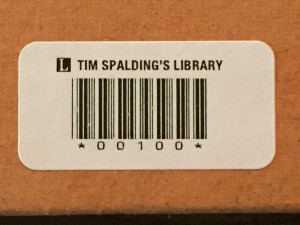
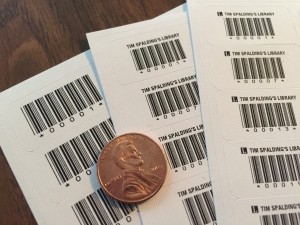
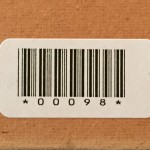
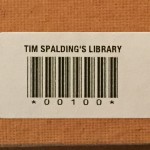
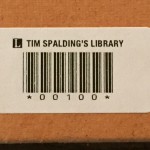
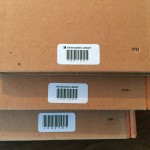
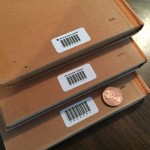
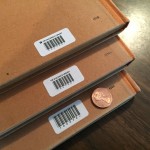
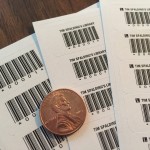
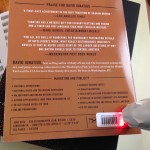
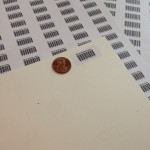
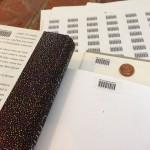
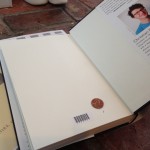
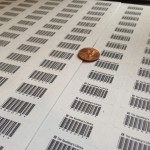
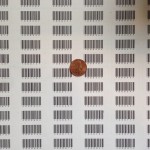
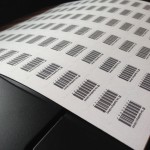


If they come in sheets of 102, are the sets of “500” actually 508? If so, and someone orders a set of 500 and then comes back and orders another set later, will they have duplicate numbers from the first run of 501-508 and the second one?
Good question. I know it was already answered over on the Talk thread, but I’m posting here, as well. To keep the numbers simple, the last two labels on every sheet will be blank. So, no need to worry about duplicates!
As someone who pays $70 per 1000 barcodes (because screw my school’s corporate agreements), I’m very intrigued. Can the buyer set the start/end numbers? I would strongly consider switching to these, if I can set the starting code.
You can always manually type in any barcode you’d like, by double-clicking on the barcode field in Your Books, and you can select “Manually entered” or “Sequential numbers” for your barcode system, over on the Barcode Settings page.
If you choose sequential numbers, you have two options for how those numbers are applied: highest barcode +1, or lowest free barcode.
Can this system translate titles (without isbn) into barcodes? How about books that have an isbm # and no bacode? I don’t know much about the subject, therefore I apologize if this question is particularly stupid.
I’m not sure what you mean by “translate titles” into barcodes. You can apply barcodes to any books or items you have cataloged in LibraryThing, regardless of ISBN. If there’s anything I can do to further clarify things, feel free to email me! (loranne@librarything.com)
[…] lets you catalog your personal library. It’s a fun time and this week I saw this from them. Barcode labels. And my little geek-worked-in-the-school-library-unofficially-heart went pitter pat. Yeah, going to […]
Would we/could we put “label protectors”, which are available from library supply stores, over your barcode labels to make them last longer. (That’s what we do with our spine labels and it makes a huge difference in durability).
If we used label protectors”, would your bar code labels still be scannable? (We currently can’t scan but might someday).
We haven’t explicitly tested these barcode labels with label protectors, but we did do an awful lot of research on quality and cost before selecting the specific labels we’re going with. I can’t see how label protectors would pose a problem.
If you’d like to test them out and let us know, we’ll certainly give you a refund if they don’t work out for you.
They work! I run a small Black feminist library, and put book jacket protectors on the hardcovers and put the barcode underneath it, directly on the book. It saves me from having to protect the sticker with an additional layer of protection. It has worked out fine.
about how long does it take to receive barcodes once you order them?
hi loranne
pls advise how to order a customised printed barcode as follow ;
UNITY SECONDARY SCHOOL
3611500500
You can find printed barcodes available in our store here: http://www.librarything.com/more/store/barcodes
Make sure you’ve selected “Labels with text” and entered the desired text you’d like to appear on your barcode labels.
Barcodes are sold in packets of 500, and you can select the range of numbers you’d like to purchase. Currently, barcode numbers can be selected from our store in a range from 00001 – 15000, but we can accommodate up to 7-digit barcodes, like the one you’ve mentioned.
We’re working on expanding the barcode range on the store, but that may take some time.
In the meantime, you can place your order through the store for the number of barcode packets you want, using any of the number ranges currently available. After you place your order, please email us (info@librarything.com) and include the correct range of numbers you’d like us to print for you, so 3611500500 would be included in the range of 3611500500 – 3611500599.
If you have any questions, please feel free to email me directly (loranne@librarything.com), and I’ll be happy to help.
Can this system translate titles (without isbn) into barcodes? How about books that have an isbm # and no bacode? I don’t know much about the subject, therefore I apologize if this question is particularly stupid.
I’m not quite sure what you mean by “translate” into barcodes,” I’m afraid. However, I can tell you that barcodes can be applied to anything you’ve cataloged on LibraryThing—no ISBN required. You can find info on how barcodes work within LibraryThing here. Feel free to email me at loranne@librarything.com/ if you have any further questions.
I just upgraded my LibraryThing account by adding Tiny Cat. Is there a plan to allow me to use my iPhone to scan barcodes for the purpose of inventory or lending?
Thanks!
Do you post barcodes to New Zealand?
Cost for 5000 numbers starting from 2000- 9000?
Hillcrest School
42 Princess Street
Pahaiatua
NEW ZEALAND
Absolutely! Go ahead and submit your order on the Store page.
Barcodes are $10 for the first sheet (of 500 labels), and $5 for each additional sheet after that. So, for barcode numbers 2001-9000 (2000 is only included in the 1501-2000 sheet), you’d be looking at $75, plus $10 for shipping, so a grand total of $85 USD.
If you really need barcode #2000, that would be an extra $5 on top of that for the 1501-2000 sheet.
Feel free to email us at info@librarything.com if you have any further questions.